



Welcome to the Parent Curriculum Advisory Committee Meeting K. Scussa 2017
This Evening’s Agenda Video ~ Three Rules to Spark Learning ● Rationale for Shifts ● Hands-on Exploration of Phenomena ● What will Classroom Instruction look like? ● Timelines ● K. Scussa 2017
Three Rules to Spark Learning... K. Scussa 2017
Why has Education Changed? THEN NOW K. Scussa 2017
Why has Education Changed? THEN NOW K. Scussa 2017
Why has Education Changed? THEN NOW K. Scussa 2017
Major Shift Between “Then and Now”? “We now live in a world where information is potentially unlimited. Information is cheap but meaning is expensive.” ~ George Dyson K. Scussa 2017
NGSS Promotes the Exploration of Phenomena ● Why does moss grow on one side of a tree? ● Why are magnets attracted to one another? ● Why does white light separate into colors? ● Why do objects fall toward Earth? ● What causes a volcanic eruption? K. Scussa 2017
Through the Eyes of a Child.... Let’s explore phenomena! Why is there a far side of our Moon when viewed from Earth? K. Scussa 2017
NGSS Opening Activity We know… No matter where the Moon is in its orbit around the Earth, we only see one side of the Moon. You can see by the phases of the Moon that the near side is our view throughout the month. The picture of the far side of the Moon was taken from space. K. Scussa 2017
NGSS Opening Activity Your Challenge~ Develop a model to show why we only see the near side of the Moon and never see the far side of the Moon from Earth. The construction of your model may include, but is not limited to the following items: ● styrofoam balls ● chart paper ● playdough ● straws ● construction paper ● your own bodies! ● flashlight K. Scussa 2017
Let’s share our thinking! What’s your reasoning? K. Scussa 2017
Why is this the right time to implement? K. Scussa 2017
Introducing the Next Generation Science Standards What are Standards? Standards are the learning goals for what students should know and be able to do at each grade level. Teachers know what to teach ● Parents know what children are expected to learn ● School districts (and teachers) know what to assess ● A teacher decides how best to teach students to achieve this goal. K. Scussa 2017
What Should We Expect to See in the Classroom? 5E Instructional Model Engagement - students’ prior knowledge accessed and interest ○ engaged in the phenomenon Exploration - students participate in an activity that facilitates ○ conceptual change Explanation - students generate an explanation of the phenomenon ○ Elaboration - students' understanding of the phenomenon challenged ○ and deepened through new experiences Evaluation - students assess their understanding of the phenomenon ○ K. Scussa 2017
What states have adopted the NGSS? Arkansas, California, Connecticut, Delaware, Hawaii, Illinois, Iowa, Kansas, Kentucky, Maryland, Nevada, New Jersey, Oregon, Rhode Island, Vermont, and Washington, along with the District of Columbia (D.C.) As of February 2016, 40 states have shown interest in the standards and 16 states have formally adopted the standards. K. Scussa 2017
Timelines for Curriculum Writing and Implementation Grades 6 - 12 2014-15 ~ Review Framework ● 2015-16 ~ Revise Curriculum ● 2016-17 ~ Implement NGSS ● Grades K - 5 2015-16 ~ Review Framework ● 2016-17 ~ Revise Curriculum ● 2017-18 ~ Implement NGSS ● K. Scussa 2017
Thank You For Coming! K. Scussa 2017
Recommend
More recommend